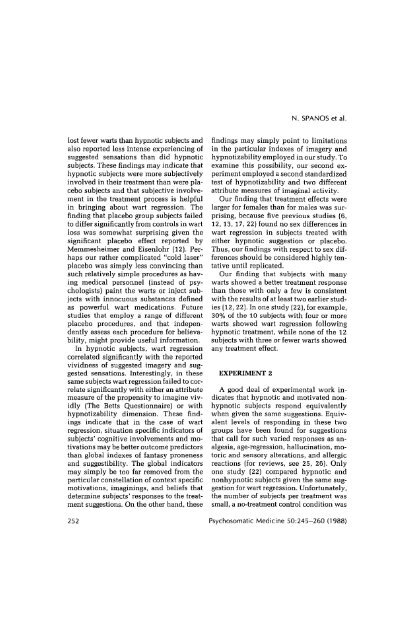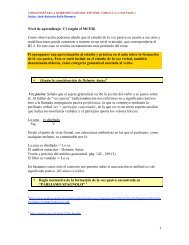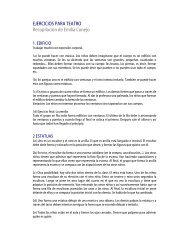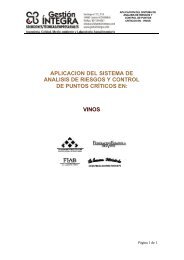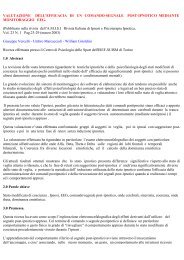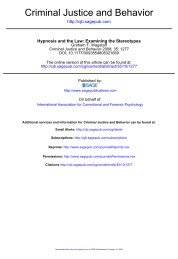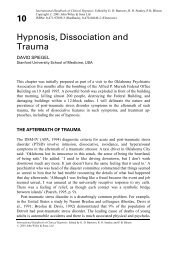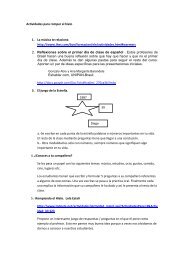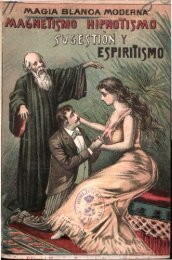Hypnosis, Placebo, and Suggestion in the Treatment of Warts
Hypnosis, Placebo, and Suggestion in the Treatment of Warts
Hypnosis, Placebo, and Suggestion in the Treatment of Warts
Create successful ePaper yourself
Turn your PDF publications into a flip-book with our unique Google optimized e-Paper software.
N. SPANOSetal.lost fewer warts than hypnotic subjects <strong>and</strong>also reported less <strong>in</strong>tense experienc<strong>in</strong>g <strong>of</strong>suggested sensations than did hypnoticsubjects. These f<strong>in</strong>d<strong>in</strong>gs may <strong>in</strong>dicate thathypnotic subjects were more subjectively<strong>in</strong>volved <strong>in</strong> <strong>the</strong>ir treatment than were placebosubjects <strong>and</strong> that subjective <strong>in</strong>volvement<strong>in</strong> <strong>the</strong> treatment process is helpful<strong>in</strong> br<strong>in</strong>g<strong>in</strong>g about wart regression. Thef<strong>in</strong>d<strong>in</strong>g that placebo group subjects failedto differ significantly from controls <strong>in</strong> wartloss was somewhat surpris<strong>in</strong>g given <strong>the</strong>significant placebo effect reported byMemmesheimer <strong>and</strong> Eisenlohr (12). Perhapsour ra<strong>the</strong>r complicated "cold laser"placebo was simply less conv<strong>in</strong>c<strong>in</strong>g thansuch relatively simple procedures as hav<strong>in</strong>gmedical personnel (<strong>in</strong>stead <strong>of</strong> psychologists)pa<strong>in</strong>t <strong>the</strong> warts or <strong>in</strong>ject subjectswith <strong>in</strong>nocuous substances def<strong>in</strong>edas powerful wart medications. Futurestudies that employ a range <strong>of</strong> differentplacebo procedures, <strong>and</strong> that <strong>in</strong>dependentlyassess each procedure for believability,might provide useful <strong>in</strong>formation.In hypnotic subjects, wart regressioncorrelated significantly with <strong>the</strong> reportedvividness <strong>of</strong> suggested imagery <strong>and</strong> suggestedsensations. Interest<strong>in</strong>gly, <strong>in</strong> <strong>the</strong>sesame subjects wart regression failed to correlatesignificantly with ei<strong>the</strong>r an attributemeasure <strong>of</strong> <strong>the</strong> propensity to imag<strong>in</strong>e vividly(The Betts Questionnaire) or withhypnotizability dimension. These f<strong>in</strong>d<strong>in</strong>gs<strong>in</strong>dicate that <strong>in</strong> <strong>the</strong> case <strong>of</strong> wartregression, situation specific <strong>in</strong>dicators <strong>of</strong>subjects' cognitive <strong>in</strong>volvements <strong>and</strong> motivationsmay be better outcome predictorsthan global <strong>in</strong>dexes <strong>of</strong> fantasy proneness<strong>and</strong> suggestibility. The global <strong>in</strong>dicatorsmay simply be too far removed from <strong>the</strong>particular constellation <strong>of</strong> context specificmotivations, imag<strong>in</strong><strong>in</strong>gs, <strong>and</strong> beliefs thatdeterm<strong>in</strong>e subjects' responses to <strong>the</strong> treatmentsuggestions. On <strong>the</strong> o<strong>the</strong>r h<strong>and</strong>, <strong>the</strong>sef<strong>in</strong>d<strong>in</strong>gs may simply po<strong>in</strong>t to limitations<strong>in</strong> <strong>the</strong> particular <strong>in</strong>dexes <strong>of</strong> imagery <strong>and</strong>hypnotizability employed <strong>in</strong> our study. Toexam<strong>in</strong>e this possibility, our second experimentemployed a second st<strong>and</strong>ardizedtest <strong>of</strong> hypnotizability <strong>and</strong> two differentattribute measures <strong>of</strong> imag<strong>in</strong>al activity.Our f<strong>in</strong>d<strong>in</strong>g that treatment effects werelarger for females than for males was surpris<strong>in</strong>g,because five previous studies (6,12, 13, 17, 22) found no sex differences <strong>in</strong>wart regression <strong>in</strong> subjects treated wi<strong>the</strong>i<strong>the</strong>r hypnotic suggestion or placebo.Thus, our f<strong>in</strong>d<strong>in</strong>gs with respect to sex differencesshould be considered highly tentativeuntil replicated.Our f<strong>in</strong>d<strong>in</strong>g that subjects with manywarts showed a better treatment responsethan those with only a few is consistentwith <strong>the</strong> results <strong>of</strong> at least two earlier studies(12, 22). In one study (22), for example,30% <strong>of</strong> <strong>the</strong> 10 subjects with four or morewarts showed wart regression follow<strong>in</strong>ghypnotic treatment, while none <strong>of</strong> <strong>the</strong> 12subjects with three or fewer warts showedany treatment effect.EXPERIMENT 2A good deal <strong>of</strong> experimental work <strong>in</strong>dicatesthat hypnotic <strong>and</strong> motivated nonhypnoticsubjects respond equivalentlywhen given <strong>the</strong> same suggestions. Equivalentlevels <strong>of</strong> respond<strong>in</strong>g <strong>in</strong> <strong>the</strong>se twogroups have been found for suggestionsthat call for such varied responses as analgesia,age-regression, halluc<strong>in</strong>ation, motoric<strong>and</strong> sensory alterations, <strong>and</strong> allergicreactions (for reviews, see 25, 26). Onlyone study (22) compared hypnotic <strong>and</strong>nonhypnotic subjects given <strong>the</strong> same suggestionfor wart regression. Unfortunately,<strong>the</strong> number <strong>of</strong> subjects per treatment wassmall, a no-treatment control condition was252 Psychosomatic Medic<strong>in</strong>e 50:245-260 (1988)


